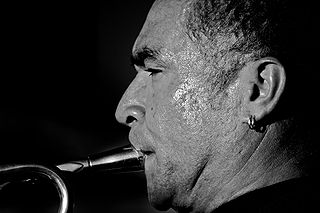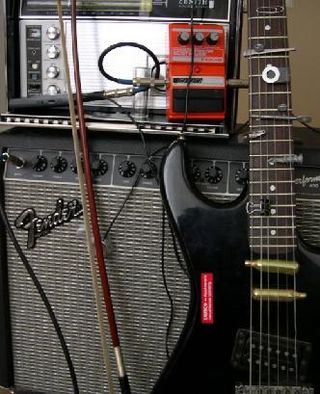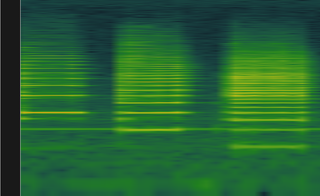
A brass instrument is a musical instrument that produces sound by sympathetic vibration of air in a tubular resonator in sympathy with the vibration of the player's lips. The term labrosone, from Latin elements meaning "lip" and "sound", is also used for the group, since instruments employing this "lip reed" method of sound production can be made from other materials like wood or animal horn, particularly early or traditional instruments such as the cornett, alphorn or shofar.

The cornet is a brass instrument similar to the trumpet but distinguished from it by its conical bore, more compact shape, and mellower tone quality. The most common cornet is a transposing instrument in B♭. There is also a soprano cornet in E♭ and cornets in A and C. All are unrelated to the Renaissance and early Baroque cornett.

Embouchure or lipping is the use of the lips, facial muscles, tongue, and teeth in playing a wind instrument. This includes shaping the lips to the mouthpiece of a woodwind instrument or the mouthpiece of a brass instrument. The word is of French origin and is related to the root bouche, 'mouth'. Proper embouchure allows instrumentalists to play their instrument at its full range with a full, clear tone and without strain or damage to their muscles.

The French horn is a brass instrument made of tubing wrapped into a coil with a flared bell. The double horn in F/B♭ is the horn most often used by players in professional orchestras and bands, although the descant and triple horn have become increasingly popular. A musician who plays a horn is known as a horn player or hornist.

The trombone is a musical instrument in the brass family. As with all brass instruments, sound is produced when the player's vibrating lips cause the air column inside the instrument to vibrate. Nearly all trombones use a telescoping slide mechanism to alter the pitch instead of the valves used by other brass instruments. The valve trombone is an exception, using three valves similar to those on a trumpet, and the superbone has valves and a slide.

The trumpet is a brass instrument commonly used in classical and jazz ensembles. The trumpet group ranges from the piccolo trumpet—with the highest register in the brass family—to the bass trumpet, pitched one octave below the standard B♭ or C trumpet.

In music, extended technique is unconventional, unorthodox, or non-traditional methods of singing or of playing musical instruments employed to obtain unusual sounds or timbres.

Pedal tones are special low notes in the harmonic series of brass instruments. A pedal tone has the pitch of its harmonic series' fundamental tone. Its name comes from the foot pedal keyboard pedals of a pipe organ, which are used to play 16' and 32' sub-bass notes by pressing the pedals with the player's feet. Brasses with a bell do not naturally vibrate at this frequency.
A multiphonic is an extended technique on a monophonic musical instrument in which several notes are produced at once. This includes wind, reed, and brass instruments, as well as the human voice. Multiphonic-like sounds on string instruments, both bowed and hammered, have also been called multiphonics, for lack of better terminology and scarcity of research.

A natural trumpet is a valveless brass instrument that is able to play the notes of the harmonic series.

A single-reed instrument is a woodwind instrument that uses only one reed to produce sound. The very earliest single-reed instruments were documented in ancient Egypt, as well as the Middle East, Greece, and the Roman Empire. The earliest types of single-reed instruments used idioglottal reeds, where the vibrating reed is a tongue cut and shaped on the tube of cane. Much later, single-reed instruments started using heteroglottal reeds, where a reed is cut and separated from the tube of cane and attached to a mouthpiece of some sort. By contrast, in a double reed instrument, there is no mouthpiece; the two parts of the reed vibrate against one another. Reeds are traditionally made of cane and produce sound when air is blown across or through them. The type of instruments that use a single reed are clarinets and saxophone. The timbre of a single and double reed instrument is related to the harmonic series caused by the shape of the corpus. E.g. the clarinet is only including the odd harmonics due to air column modes canceling out the even harmonics. This may be compared to the timbre of a square wave.

The mouthpiece on brass instruments is the part of the instrument placed on the player's lips. The mouthpiece is a circular opening that is enclosed by a rim and that leads to the instrument via a semi-spherical or conical cavity called the cup. From the cup, a smaller opening leads into a tapered cylindrical passage called the backbore. The backbore is housed in a tapered shank, which is inserted into an opening called the receiver on the main body of the instrument.
Growling is a musical technique where the instrumentalist vocalizes into the instrument to alter quality of the sound. Growling is used primarily in rock and blues style playing, it is also frequently used in klezmer music; it is popular in the woodwind family of instruments, especially the saxophone, though it is also commonly used on brass instruments, as well. It is commonly used by mainstream artists such as Ben Webster, Illinois Jacquet and Earl Bostic. Outside of these styles and instruments, it is often considered a novelty effect.

The saxotromba is a valved brass instrument invented by the Belgian instrument-maker Adolphe Sax around 1844. It was designed for the mounted bands of the French military, probably as a substitute for the French horn. The saxotrombas comprised a family of half-tube instruments of different pitches. By about 1867 the saxotromba was no longer being used by the French military, but specimens of various sizes continued to be manufactured until the early decades of the twentieth century, during which time the instrument made sporadic appearances in the opera house, both in the pit and on stage. The instrument is often confused with the closely related saxhorn.

A wind instrument is a musical instrument that contains some type of resonator in which a column of air is set into vibration by the player blowing into a mouthpiece set at or near the end of the resonator. The pitch of the vibration is determined by the length of the tube and by manual modifications of the effective length of the vibrating column of air. In the case of some wind instruments, sound is produced by blowing through a reed; others require buzzing into a metal mouthpiece, while yet others require the player to blow into a hole at an edge, which splits the air column and creates the sound.

Saxophone technique refers to the physical means of playing the saxophone. It includes how to hold the instrument, how the embouchure is formed and the airstream produced, tone production, hands and fingering positions, and a number of other aspects. Instrumental technique and corresponding pedagogy is a topic of much interest to musicians and teachers and therefore has been subjected to personal opinions and differences in approach. Over the course of the saxophone's performance history, notable saxophonists have contributed much to the literature on saxophone technique.
Troorkh is a composition for trombone and orchestra by Greek composer Iannis Xenakis. It was commissioned by Swedish Radio for Swedish trombonist Christian Lindberg, to whom it is dedicated, and was completed in 1991. It was premiered on March 26, 1993 at Berwald Hall in Stockholm by the Swedish Radio Orchestra under Esa-Pekka Salonen, with Lindberg as the soloist.
Eonta is a composition for piano, two trumpets, and three tenor trombones by Iannis Xenakis. It was written in 1963–64, and was premiered on December 16, 1964, by the Ensemble du Domaine Musical, with Yuji Takahashi on piano and Pierre Boulez conducting. Its duration is approximately 18 minutes.
Phlegra is a composition for ensemble by composer Iannis Xenakis. It was composed in 1975.














